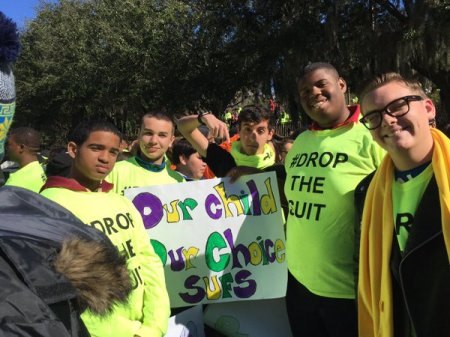
(Guest Post by Jason Bedrick)
The legal attacks on school choice programs are dropping like characters in a George R.R. Martin novel. Last week, a Nevada judge dismissed a case against the state’s education savings account program. Today, a Florida judge dismissed a case against several of the state’s school choice programs.
The Florida lawsuit originally concerned whether the state was adequately funding public education, but in 2014 the plaintiffs amended their suit to challenge a wide range of policies, including state accountability statutes, charter schools, tax-credit scholarships, and the McKay Scholarship Program for Students with Disabilities. Last year, a judge ruled that the plaintiffs did not have standing to challenge the private school choice programs, but this ruling also rejects their substantive claims that the choice programs somehow harm the traditional district school system:
[T]he Court finds no negative effect on the uniformity or efficiency of the State system of public schools due to these choice programs, and indeed, evidence was presented that these school-choice programs are reasonably likely to improve the quality and efficiency of the entire system. […]
Plaintiffs’ specific allegations regarding the constitutional implications of three of Florida’s choice programs- charter schools, the FTC Program, and the McKay Program- are similarly unsupported by the weight of the evidence. […]
The Court has already held that Plaintiffs lack standing to challenge the FTC Program, and the Court further concludes that the weight of the evidence does not support their speculative allegations that the FTC Program diverts state funding or has any material, detrimental effect on Florida’s system of public schools.
The weight of the evidence similarly does not support Plaintiffs’ allegations about the McKay Program, which is limited to “Students with Disabilities” and requires eligible students to have an individual educational or accommodation plan under federal law. […] As indicated by the Florida Supreme Court, parental decisions to send individual children with special needs to private school do not implicate the uniformity of the broader public school system- regardless of whether some of those parents accept scholarship funds from the State.
BOOOOOOOOOOOOOOOOOOM!!!!!!!

This decision constitutes one more legal stake in the heart of the canard that educational choice programs harm students attending traditional district schools. As Jon East pointed out at RedefinED yesterday, judges presiding over a separate anti-choice lawsuit in Florida cast a gimlet eye on similar claims during oral arguments last week:
[Florida Education Association] attorney Lynn Hearn: “The loss of $300 million at a minimum to the Florida public school system … is absolutely a fact.”
Presiding Judge Lori S. Rowe: “In your complaint, you haven’t actually alleged that there is a $300 million loss to the Florida education budget, have you?… In fact, the $300 million you’re referring to are the funds that flow into the scholarship program, correct?”
Attorney Hearn: “Well, that’s where the number arrives from, your honor. But we absolutely do allege that that amount has left the public schools in favor of the scholarship program. That’s because of the way the Florida schools are funded. They are funded on a per-student basis. So, during that year, 2013-14, there were 60,000 students who left the Florida public school system.”
Judge Ross L. Bilbrey: “But doesn’t that mean there are 60,000 fewer students that the state has to pay to educate?”
Attorney Hearn: “It does your honor. But the funding of students in our public schools is, uh, we’re not funding widgets, the funding formula for students is not a perfect correlation to the variable cost of funding that student.”
Judge Rowe: “But exactly what is the special injury you are articulating here? You haven’t alleged that any individual student is suffering. You haven’t alleged that per-student funding has been reduced. You haven’t even alleged that the education budget has been reduced.”
Essentially, the union wants to argue the district school system has some special claim on students–and therefore the public funds attached to those students–without openly making that claim. After all, the district school system can’t suffer a “loss” unless they somehow owned those funds to begin with, but parents have no such obligation to enroll their children at their zoned district school, or any district school for that matter. They feel entitled to those children and the corresponding funding, but they know they can’t make that claim explicitly because, well, it’s ludicrous. That’s why the union is having such a hard time articulating any special injury–and why they’re likely to lose that lawsuit as well.
For more information on today’s decision, see Travis Pillow’s write up at RedefinED.
*****
UPDATE: Supplementing his opinion, the judge issued a 179-page Appendix for Findings of Fact which, among many other things, explains that Florida’s tax-credit scholarship program relies on private (not public) funding and explains that the plaintiffs failed to demonstrate any injury resulting from the program:
The Florida Tax Credit Scholarship Program (the ―FTC Program‖) allows Florida taxpayers to apply for tax credits ―to make private, voluntary contributions‖ to fund scholarships for children attending eligible K–12 private schools.767 Plaintiffs allege that the FTC Program violates the uniformity and efficiency requirements of Article IX, Section 1(a) by diverting public funds to private schools that are not subject to the same requirements as schools within the State‘s system of free public schools.
The Court has previously found that the FTC Program, which allows third parties to obtain tax credits for making private donations, does not involve public funds, legislative appropriations, or the State‘s ―provision‖ for a ―system of free public schools‖ under Article IX. Because the private donations that fund the FTC Program are not legislative appropriations, the Court has previously determined that Plaintiffs lack taxpayer standing to assert a challenge to this program under Florida law.
Plaintiffs have also failed to prove any special injury that would allow them to challenge the FTC Program. […]
[A]ny connection between the FTC Program and appropriations to support Florida‘s system of free public schools—not to mention the overall quality of that system—is purely speculative. There was no persuasive evidence presented that the FTC Program has any direct or indirect impact on public-school funding or on the uniformity, efficiency, safety, security, or quality of Florida‘s public schools. […]
Even if tax credits resulted in a decrease in the number of students attending the public schools, local school districts are not responsible for educating students who attend private schools.
The appendix is also is chock-full of citations of some dude named Jay Greene. Here’s a taste:
3rd Grade Retention Policy
Florida‘s third-grade retention policy also is supported by academic research. Dr. Jay Greene, a professor of education and head of the Department of Education Reform at the University of Arkansas, has extensively studied the effect of Florida‘s policy. Dr. Greene‘s studies, which are published in a peer-reviewed journal, concluded that Florida‘s test-based retention policy significantly improves the academic achievement of students who are retained.239 Plaintiffs did not present any evidence countering Dr. Greene‘s findings.
Resources & Results
Plaintiffs allege that the overall level of funding in Florida is not sufficient to provide a uniform, efficient, safe, secure and high quality system of public education.784 Plaintiffs assert that the performance outcomes for certain groups of students indicate that school funding is insufficient.
Plaintiffs, however, have not met their burden of proving a causal relationship between the level of resources available to schools in Florida and student outcomes. Indeed, as described below, the weight of the evidence presented on that issue establishes a lack of any causal relationship between additional financial resources and improved student outcomes. […]
In addition to Dr. Hanushek, Defendants presented findings of Dr. Jay Greene, a professor of education and head of the Department of Education Reform at the University of Arkansas. Dr. Greene statistically analyzed school district-level variables throughout the state of Florida, including per-pupil spending, teacher characteristics, and discipline rates, and found no relationship between these variables and student outcomes.
Specifically, Dr. Greene examined school district per-pupil expenditures and percentages of students proficient on the Florida Comprehensive Assessment Test (―FCAT‖)797 for grades 3 through 10 in reading and math; grades 5, 8, and 11 in science; as well as highschool graduation rates, for school years 2007–08 to 2012–13. The analysis revealed no connection between higher amounts of funding available in school districts and better student performance.
Dr. Greene also conducted regression analyses of spending and performance data, controlling for student demographic differences and prior levels of achievement across school districts. The demographic characteristics that were controlled included the proportion of minority students, proportion of students receiving free or reduced price lunch, the proportion of students classified as English language learners (―ELL‖), and the proportion of students with a disability who had an individual educational plan (―IEP‖), as well as academic outcomes in the prior year. The purpose of these analyses was to examine whether school districts would have better student outcomes if they had more resources, assuming school districts had the same demographic composition and prior year‘s academic outcomes. Dr. Greene‘s regression analyses revealed that there is no pattern between the level of spending in Florida school districts and student performance on the FCAT or high school graduation rates.
Teacher Experience
In addition, Dr. Greene evaluated the assertion by Plaintiffs that teacher qualifications and experience characteristics impact student performance, and that districts with high-minority and low-income student populations have a lower percentage of qualified, experienced teachers. Consistent with his other findings, Dr. Greene found no statistical relationship between the proportion of novice (first-year teachers) or ―highly qualified teachers, as defined by the Florida Department of Education, and student performance on the FCAT or high school graduation rates. Likewise, Dr. Greene found no statistical relationship between the percentage of minority and low-income students in a district and the proportion of novice or highly qualified teachers.
Suspension Rates
Dr. Greene also addressed Plaintiffs‘ assertion that high suspension rates are attributable to a lack of school district resources and lead to lower student performance outcomes. As above, Dr. Greene conducted regression analyses that controlled for student demographic characteristics and prior student outcomes. Dr. Greene found no relationship between the rate at which students are given out-of-school suspensions in Florida school districts and FCAT reading, math, or science proficiency, or graduation rates.
Court’s Conclusion re: the Evidence
The Court accepts Dr. Greene‘s conclusions and finds that they corroborate other evidence in the case showing the lack of causal relationship between the level of resources available in Florida schools and student outcomes, as well as evidence showing that the level of resources available is sufficient for a high quality system.
Although Plaintiffs bear the burden of proof in this case, neither Plaintiffs‘ expert witnesses nor their school-district witnesses presented analyses or studies rebutting the work of Drs. Hanushek and Greene. In fact, the weight of the evidence shows that despite budget cutbacks associated with the Great Recession, student performance continued to improve in the period 2007–08 to 2014–15.




 Posted by Jason Bedrick
Posted by Jason Bedrick 





 (Guest Post by Matthew Ladner)
(Guest Post by Matthew Ladner)


